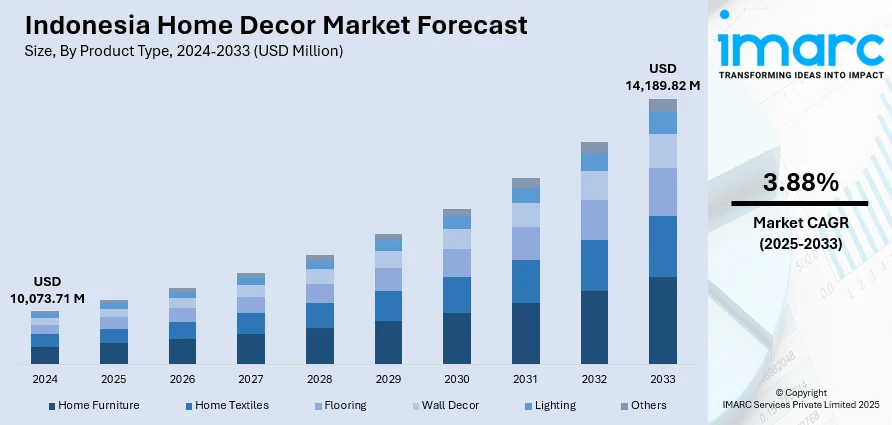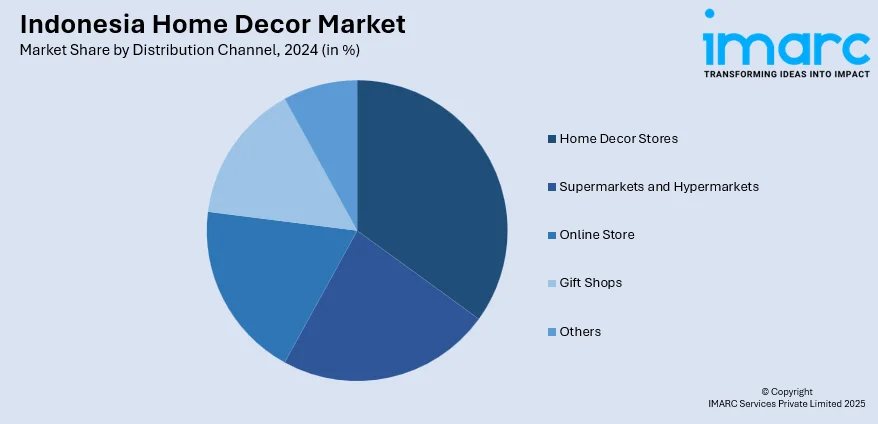
Indonesia Home Decor Market Size, Share, Trends and Forecast by Product Type, Distribution Channel, and Region, 2025-2033
Indonesia Home Decor Market Overview:
The Indonesia home decor market size reached USD 10,073.71 Million in 2024. The market is projected to reach USD 14,189.82 Million by 2033, exhibiting a growth rate (CAGR) of 3.88% during 2025-2033. The market is driven by rapid urbanization, a growing middle class, increased disposable income, and a shift towards modern and personalized home interiors. The demand for eco-friendly and sustainable products is also contributing to the rise in the Indonesia home decor market share.
|
Report Attribute
|
Key Statistics
|
|---|---|
|
Base Year
|
2024
|
|
Forecast Years
|
2025-2033
|
|
Historical Years
|
2019-2024
|
| Market Size in 2024 | USD 10,073.71 Million |
| Market Forecast in 2033 | USD 14,189.82 Million |
| Market Growth Rate 2025-2033 | 3.88% |
Indonesia Home Decor Market Trends:
Rising Urbanization and Modern Lifestyles
As Indonesia's urban population continues to increase, there is a noticeable trend toward more contemporary living areas that suit modern lifestyles. With the growth of metropolitan areas, people are now able to customize their houses by combining grace and utility through home décor. Urban inhabitants dwelling in regions like Jakarta and Surabaya are becoming increasingly prominent, which is fueling the need for creative and compact furniture. A major factor in the expansion of the Indonesian home décor market is the trend of updating living areas, frequently with an emphasis on simplicity and clean lines. The need for home furnishings and accessories that combine convenience and style is increasing as a result of this shift in lifestyle. For instance, in September 2024, Indonesia’s SMEs Minister envisions the country becoming a global home decor hub, driven by local furniture and craft exports valued at USD 3.5 Billion. He emphasized enhancing the competitiveness of micro, small, and medium enterprises (MSMEs) in the furniture sector through collaborations and quality improvements to access global markets.

To get more information on this market, Request Sample
Demand for Sustainable and Eco-Friendly Products
In recent years, there has been a significant transformation in the Indonesia home decor industry, with the trend moving towards environmentally friendly consumers. As concern for the environment increases, Indonesian consumers are now looking for sustainable and eco-friendly decor products. This encompasses the use of furniture made from reclaimed wood, natural textiles, and other sustainable resources. Consequently, most home decor companies have started to produce items that comply with green techniques. The need for such items is not just environmentally motivated but also due to the need for healthier homes. Green home decor is slowly picking up, contributing positively to the market and aligning with worldwide sustainability patterns, thereby supporting the growth of the Indonesia home decor market as a whole. For instance, the Indonesia Meuble & Design Expo (IFFINA) took place in Tangerang in September 2024, with the theme "Sustainable by Design." The event, supported by the Ministry of Co-operatives & SMEs and ASMINDO, saw a 20% increase in targeted visitors and a 30% rise in transactions. Indonesia aimed to capture 1% of the global furniture market, potentially earning USD 7 Billion.
Digital Transformation and E-Commerce Growth
The Indonesia e-commerce market was valued at USD 354.6 Billion in 2024 and is expected to grow to USD 760.8 Billion by 2033, with a compound annual growth rate (CAGR) of 9.07% from 2025 to 2033. The growth of e-commerce has been particularly influential in the Indonesia home decor market, with consumers now having the ease of access to a large variety of products. Online retail websites have become extremely important to local and international companies, as they enable customers to browse and shop from home. As digital technologies are adopted at a greater rate, home decor firms are prioritizing improving their online standing, incorporating augmented reality (AR) technology to enable consumers to imagine products in their homes. Expansion in e-commerce has increased market access, with home decor brands then able to reach a wider and broader consumer base, which is a factor in the high growth of the Indonesia home decor market growth.
Indonesia Home Decor Market Segmentation:
IMARC Group provides an analysis of the key trends in each segment of the market, along with forecasts at the country/regional levels for 2025-2033. Our report has categorized the market based on product type and distribution channel.
Product Type Insights:
- Home Furniture
- Home Textiles
- Flooring
- Wall Decor
- Lighting
- Others
The report has provided a detailed breakup and analysis of the market based on the product type. This includes home furniture, home textiles, flooring, wall decor, lighting, and others.
Distribution Channel Insights:

- Home Decor Stores
- Supermarkets and Hypermarkets
- Online Store
- Gift Shops
- Others
A detailed breakup and analysis of the market based on the distribution channel have also been provided in the report. This includes home decor stores, supermarkets and hypermarkets, online store, gift shops, and others.
Regional Insights:
- Java
- Sumatra
- Kalimantan
- Sulawesi
- Others
The report has also provided a comprehensive analysis of all the major regional markets, which include Java, Sumatra, Kalimantan, Sulawesi, and others.
Competitive Landscape:
The market research report has also provided a comprehensive analysis of the competitive landscape. Competitive analysis such as market structure, key player positioning, top winning strategies, competitive dashboard, and company evaluation quadrant has been covered in the report. Also, detailed profiles of all major companies have been provided.
Indonesia Home Decor Market Report Coverage:
| Report Features | Details |
|---|---|
| Base Year of the Analysis | 2024 |
| Historical Period | 2019-2024 |
| Forecast Period | 2025-2033 |
| Units | Million USD |
| Scope of the Report | Exploration of Historical Trends and Market Outlook, Industry Catalysts and Challenges, Segment-Wise Historical and Future Market Assessment:
|
| Product Types Covered | Home Furniture, Home Textiles, Flooring, Wall Décor, Lighting, Others |
| Distribution Channels Covered | Home Decor Stores, Supermarkets and Hypermarkets, Online Store, Gift Shops, Others |
| Regions Covered | Java, Sumatra, Kalimantan, Sulawesi, Others |
| Customization Scope | 10% Free Customization |
| Post-Sale Analyst Support | 10-12 Weeks |
| Delivery Format | PDF and Excel through Email (We can also provide the editable version of the report in PPT/Word format on special request) |
Key Questions Answered in This Report:
- How has the Indonesia home decor market performed so far and how will it perform in the coming years?
- What is the breakup of the Indonesia home decor market on the basis of product type?
- What is the breakup of the Indonesia home decor market on the basis of distribution channel?
- What is the breakup of the Indonesia home decor market on the basis of region?
- What are the various stages in the value chain of the Indonesia home decor market?
- What are the key driving factors and challenges in the Indonesia home decor market?
- What is the structure of the Indonesia home decor market and who are the key players?
- What is the degree of competition in the Indonesia home decor market?
Key Benefits for Stakeholders:
- IMARC’s industry report offers a comprehensive quantitative analysis of various market segments, historical and current market trends, market forecasts, and dynamics of the Indonesia home decor market from 2019-2033.
- The research report provides the latest information on the market drivers, challenges, and opportunities in the Indonesia home decor market.
- Porter's five forces analysis assist stakeholders in assessing the impact of new entrants, competitive rivalry, supplier power, buyer power, and the threat of substitution. It helps stakeholders to analyze the level of competition within the Indonesia home decor industry and its attractiveness.
- Competitive landscape allows stakeholders to understand their competitive environment and provides an insight into the current positions of key players in the market.
Need more help?
- Speak to our experienced analysts for insights on the current market scenarios.
- Include additional segments and countries to customize the report as per your requirement.
- Gain an unparalleled competitive advantage in your domain by understanding how to utilize the report and positively impacting your operations and revenue.
- For further assistance, please connect with our analysts.
 Request Customization
Request Customization
 Speak to an Analyst
Speak to an Analyst
 Request Brochure
Request Brochure
 Inquire Before Buying
Inquire Before Buying




.webp)




.webp)












